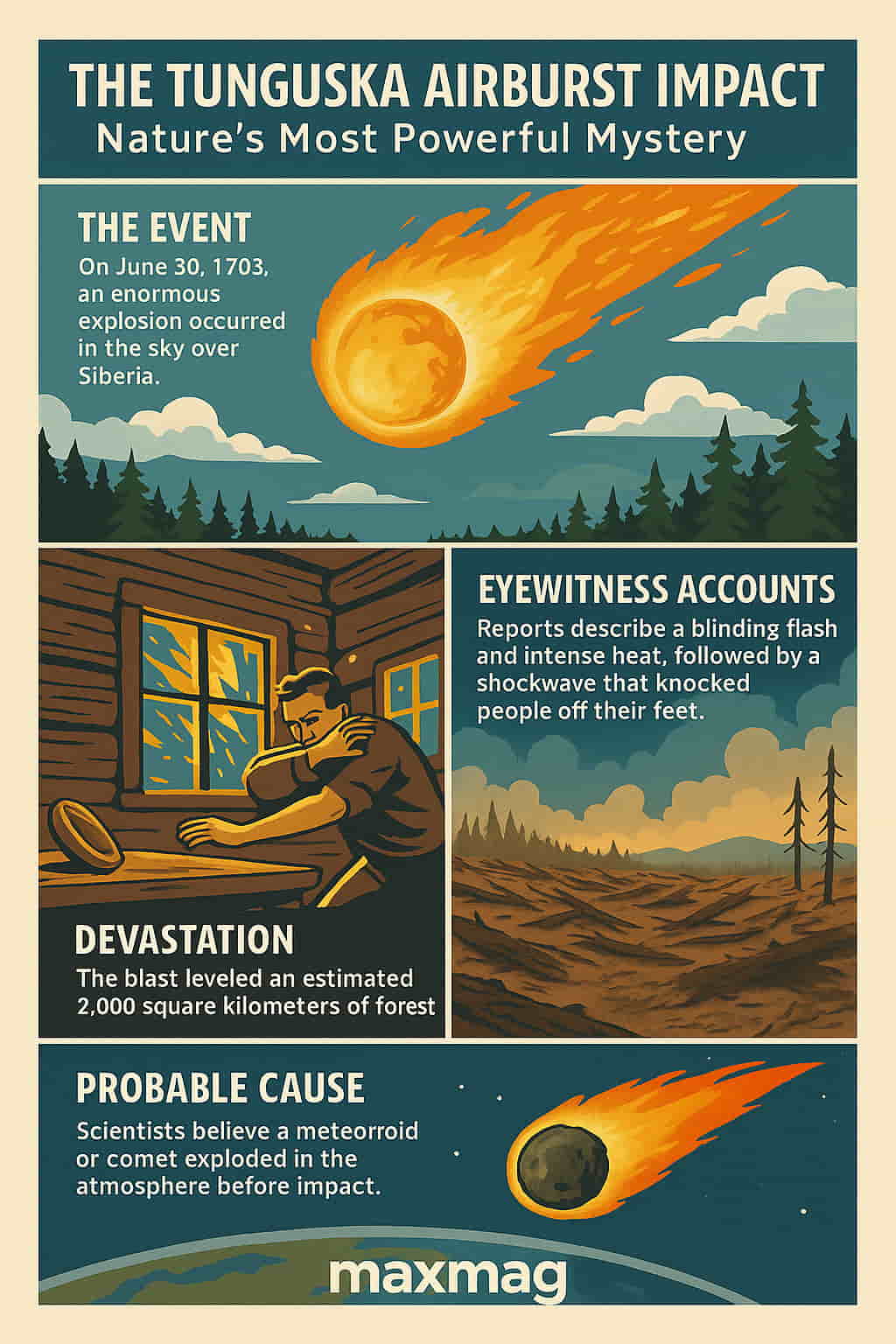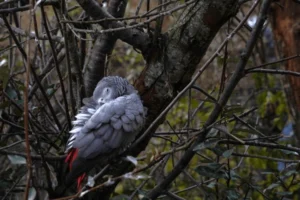
In the early hours of June 30, 1908, an extraordinary event unfolded in the skies above Siberia that would baffle scientists for more than a century. Just after 7 a.m., a blinding flash lit up the morning sky, followed by a deafening explosion that shook the Earth and leveled an area of forest larger than any modern city. The event came to be known as the Tunguska airburst impact, and it remains one of the most powerful natural phenomena ever recorded that was not caused by a volcanic eruption or earthquake.
What sets the Tunguska airburst apart from other cataclysmic events is its scale, mystery, and sheer improbability. With the energy of 10–15 megatons of TNT, the blast flattened 80 million trees across more than 2,000 square kilometers of remote taiga in central Russia — yet left no visible crater. Over a century later, scientists are still uncovering its secrets.
Unraveling the Enigma: What Really Happened?
The Tunguska airburst impact is widely accepted to have been caused by a cosmic object — either a meteoroid, asteroid, or small icy comet — that entered Earth’s atmosphere at hypersonic speed and exploded before reaching the surface. This kind of explosion is termed an “airburst,” and the Tunguska event was the most destructive one known in modern history.
Experts estimate the incoming object was 50–60 meters wide, traveling at speeds of around 27 kilometers per second. As it encountered resistance from Earth’s atmosphere, the object superheated and broke apart. The resulting explosion occurred 5 to 10 kilometers above the ground, releasing more energy than the atomic bomb dropped on Hiroshima — perhaps 1,000 times more.
Although no direct physical remnants of the object have ever been recovered, the scale of devastation and various chemical traces — such as increased levels of iridium in the soil — provide strong evidence for a cosmic origin.
NASA’s guide to how they monitor near-Earth objects explains how such impacts are tracked today.
Eyewitnesses Describe a Fire from the Sky
Because the event occurred in such a remote area, far from major population centers, relatively few people witnessed it directly. However, testimonies collected years later from Indigenous Evenki people and Russian settlers described a terrifying scene: a fireball streaking across the sky, intense heat that singed skin from miles away, and a shockwave so strong it knocked people off their feet.
One famous account, from a man named S. Semenov who lived more than 60 kilometers from the epicenter, described how the sky “split in two” and the entire northern horizon was covered with fire. He was hurled off his chair by the blast, and moments later, the windows of his home shattered.
Seismographs around the world detected the tremors, and atmospheric pressure waves circled the globe twice. For days after the explosion, strange glowing skies were reported as far away as England, likely caused by high-altitude ice crystals reflecting sunlight — an eerie phenomenon linked to the Tunguska airburst impact.
Scientific Expeditions: A Delayed Discovery
Despite its immense size and scope, the Tunguska site was not investigated until 1927, almost two decades later. Political unrest and the remoteness of the area meant that the first scientific expedition, led by Russian mineralogist Leonid Kulik, had to brave severe conditions to reach the devastated zone.
What Kulik found astonished him: a vast forest of scorched and flattened trees, with a butterfly-shaped pattern suggesting a shockwave radiating from a central point. Curiously, at the epicenter, trees remained standing but stripped of branches and bark — suggesting the blast came from directly above.
Kulik expected to find a crater or fragments of the meteorite but found none. His team encountered countless bogs and small craters that yielded no solid space rocks. Still, the pattern of destruction supported the hypothesis of an airburst.
This absence of a crater continues to be one of the most intriguing aspects of the Tunguska airburst impact, distinguishing it from typical impact sites like Meteor Crater in Arizona.

The Airburst Hypothesis and Its Evolution
Scientific Models of the Tunguska Airburst Impact
Over the decades, research has evolved significantly. In the 1970s and 1980s, advances in modeling atmospheric explosions helped scientists recreate what may have occurred over Tunguska. These simulations supported the theory that an object disintegrated in mid-air, producing a downward-facing explosion that caused a radial pattern of destruction on the ground.
Later studies analyzed tree rings from the region and discovered accelerated growth in the years following the explosion — possibly a result of increased sunlight, warmer soil, and fewer trees competing for nutrients. Soil and peat samples revealed rare isotopes, reinforcing the idea of an extraterrestrial source.
In 2013, another airburst occurred in Chelyabinsk, Russia, injuring over 1,000 people. It offered scientists an opportunity to observe a smaller-scale event with modern instruments. The Chelyabinsk explosion produced a similar mid-air detonation, validating many of the theories proposed for Tunguska and making the Tunguska airburst impact more understandable by comparison.
Scientific American covers the Chelyabinsk meteor in detail.
Conspiracy Theories and Fringe Explanations
As is often the case with mysterious and dramatic events, the Tunguska explosion has inspired a host of imaginative — and scientifically unfounded — alternative explanations.
-
Alien spacecraft crash: Perhaps the most famous theory suggests that an alien ship either exploded or was shot down over Siberia.
-
Nikola Tesla’s “death ray”: Some theorists argue that Tesla, experimenting with wireless energy transmission, inadvertently caused the explosion.
-
Mini black holes or antimatter collisions: Although scientifically intriguing, there is no credible evidence to support these claims.
-
Time travelers and supernatural forces: Some of the most speculative theories include visitors from the future or divine beings intervening in human affairs.
While these ideas often make for entertaining fiction, there’s no credible scientific basis for them. The overwhelming evidence supports a natural cosmic airburst.
Ecological and Atmospheric Consequences
The aftermath of the Tunguska airburst impact extended far beyond the immediate destruction. The massive release of energy generated heat waves that ignited forest fires, and shockwaves that flattened trees in concentric circles for dozens of kilometers.
Animals in the region — including deer, wolves, birds, and insects — were incinerated or displaced. The explosion also affected Earth’s atmosphere, sending dust and gases into the stratosphere. Climatic anomalies were recorded across Europe and Asia, including lower-than-normal temperatures and changes in cloud formation.
Later research suggested that even the Northern Hemisphere’s weather patterns may have been briefly affected. This underlines how a single localized event can have ripple effects across the planet’s ecosystems and climate.
Searching for the Crater That Isn’t There
One of the enduring puzzles of Tunguska is the lack of an impact crater. Traditional meteorite strikes create bowl-shaped depressions where the object slams into the Earth, such as Arizona’s Barringer Crater.
But in Tunguska, no such crater was ever found. This led some early researchers to question whether an explosion even took place. However, modern modeling has demonstrated that an object of Tunguska’s estimated size and composition would have disintegrated entirely in the atmosphere, releasing all its energy before impact.
Small holes or “Tunguska craters” do exist in the area, but none have yielded any fragments or metallic remains. This aligns with the comet hypothesis — if the object was composed mostly of ice, it would have vaporized completely upon atmospheric entry.
The Tunguska Legacy in Modern Science
The Tunguska airburst impact has had a lasting influence on both public awareness and scientific policy. In the aftermath of Chelyabinsk in 2013, and with growing knowledge about near-Earth objects (NEOs), governments and space agencies began investing more heavily in planetary defense.
Organizations like NASA’s Planetary Defense Coordination Office and the European Space Agency now maintain active monitoring of NEOs, developing strategies to prevent potential future disasters. One such strategy, the DART mission, aims to deflect dangerous asteroids from collision courses with Earth.
Tunguska also remains an important case study in understanding the planetary risks posed by smaller celestial bodies. While asteroid movies often focus on global extinction events, the Tunguska example proves that even modest objects can wreak regional havoc.
See how the DART mission aims to protect Earth.
Tunguska Today: Tourism, Research, and Remembrance
Today, the site of the Tunguska explosion is a destination for tourists, scientists, and adventurers. Located in the Evenkiysky District of Russia’s Krasnoyarsk Krai, the region is difficult to reach — requiring several days of travel through dense forest — but draws hundreds of visitors annually.
A small museum in the town of Vanavara exhibits photos, models, and artifacts related to the 1908 event. Guided treks lead visitors through forest paths where scorched tree trunks still lie. Researchers continue to conduct studies on tree regrowth, radiation levels, and soil chemistry.
In recent years, Tunguska has even entered the cultural mainstream. It has been featured in novels, documentaries, films, and video games — often portrayed as the backdrop for supernatural or alien stories.
Yet at its heart, the story of the Tunguska airburst impact is not about fantasy, but about the fragility of life on Earth — and the very real cosmic forces that exist just beyond our sky.
FAQ: The Tunguska Airburst Impact
Q1: What caused the Tunguska airburst impact?
It was likely caused by a meteoroid or comet fragment that exploded in Earth’s atmosphere, producing a powerful airburst without creating a surface crater.
Q2: Why didn’t the explosion leave a crater?
Because the object disintegrated in mid-air, the energy was released high in the atmosphere. This created a blast wave, not an impact hole.
Q3: Were there any human deaths?
No confirmed human casualties were reported due to the remoteness of the area. Some nomadic groups may have been indirectly affected, but records are sparse.
Q4: Is there a chance this could happen again?
Yes. In fact, smaller airbursts, like the 2013 Chelyabinsk event, occur more often than people realize. Efforts are underway to monitor space objects more closely.
Q5: What did the area look like after the blast?
The landscape was utterly transformed. Trees were flattened outward in a radial pattern, some scorched, others stripped bare but still standing at ground zero.
Q6: Can people visit the Tunguska site today?
Yes, though it’s remote. Guided tours are available, and the region now attracts researchers and tourists interested in history, science, and adventure.









